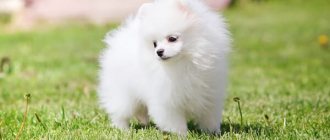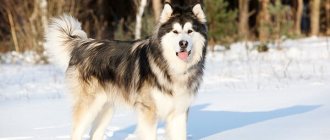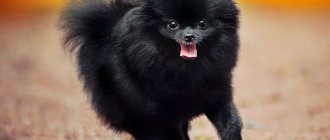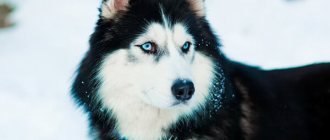Pomeranians with black coats look elegant and, at the same time, a little funny.
This color is considered one of the most ancient and classic, however, currently it is not as popular as brighter orange or, for example, cream.
The Black Pomeranian is suitable not only for connoisseurs of the classics, but also for anyone who wants a cute and playful dog with a rather rare and unusual color for this breed to live in his home.
But future owners of these dogs need to know about their breed characteristics and how to care for such a pet.
History of appearance
The history of Spitz breeds goes back more than one century. At first, these were quite large dogs, whose distinctive features were a pointed muzzle, triangular erect ears and a fluffy tail curled into a ring, as well as thick and warm two-layer fur that protected them from cold and precipitation.
It is impossible to determine exactly when this or that color appeared in the breed, however, black Spitz have existed for centuries.
Around the 15th century, such dogs with jet-black fur were already bred in the territory of modern Württemberg, where they were mainly used to guard vineyards. In those days, people preferred to keep the largest Spitz dogs, and this breed itself was considered a peasant breed, not a boudoir breed.
The nobility paid attention to the Spitz only in the 18th century. And so, in 1767, Spitz came to England, where they very quickly became a fashionable salon breed.
A significant role in this was played by the fact that the first two Spitz dogs were brought to Britain by Queen Charlotte, who became the wife of King George III and did a lot to popularize these dogs. Queen Victoria, who was her granddaughter, was fond of dog breeding and in her personal kennel the main breeding work was carried out to miniaturize this breed.
NOTE!
Victoria wanted to get really small Spitz dogs and she managed to achieve her plan. By the end of her reign, the size of these dogs was no longer 14-23 kg, as before, but 5-7 kg.
In England, the first breed club was founded in 1891, and soon the first standard appeared. In 1998, the ICF recognized the Pomeranian Spitz not as a separate breed, but as a size variety of the German Spitz, and it was included in the new standard under the name “miniature”.
Origin of the Black Pomeranian breed
Pomeranians originated in a region of Germany called Pomerania. At first these were large dogs that were used for protection, but after a while representatives of the nobility paid attention to them. Queen Charlotte, who married George III, brought a puppy with fluffy fur with her, which began the history of breed selection.
It is difficult to determine what color the ancestors of modern Pomeranians had, but the most common is considered to be a red tint - from fawn to brown. The color depends on a set of genes that determines the presence of a certain pymentum in the hairs - the charcoal shade is caused by a substance called eumelanin.
Individuals of uniform color are cultivated separately. To do this, babies are selected from litters that meet the necessary conditions, and then they are crossed with each other.
Sometimes genetics presents surprises to breeders - it is impossible to accurately predict the color of the fur of newborns.
Marriage or breed?
Black and black and tan colors are considered standard for Pomeranians.
Expert opinion
Kozhevin Semyon Kirillovich
Expert dog handler.
“The black color of Spitz dogs looks quite unusual and original. But breeding pure black representatives of this breed is associated with one very interesting nuance: all the puppy’s ancestors must be black, otherwise the color may turn black and tan as it grows up, or foreign shades will appear in it. For this reason, it is not very common to meet true black Pomeranians. However, it is wrong to think that black Spitz dogs must be only one color. After all, in addition to pure black, the standard also recognizes the black and tan color, in which bright reddish-fawn markings are located on the main background, giving the dogs a less severe appearance.”
Unrecognized colors
Some colors cause serious conflicts between representatives of the American Kennel Federation and the FCI. The first has less stringent requirements, and the following colors are acceptable:
- tricolor;
- blue;
- brindle;
- beaver;
- chocolate sable;
- blue and tan.
However, the World Federation of Canine Breeders firmly stands on its own, believing that all these options are a deviation, and their carriers should be immediately discarded and not allowed to reproduce.
Spitz puppies look like bear cubs
Creating and maintaining color standards is quite complex and painstaking work. And every breeder should know about them in order to be able to choose exactly the option that suits him and does not create unnecessary problems in the future.
Character traits
Black Pomeranians, despite their small size, do not consider themselves small dogs at all.
They are brave enough to fight back another, larger dog and, obviously, following the instincts of their ancestors, they will not miss the opportunity to bark at a stranger who finds themselves on their territory. At the same time, a Black Pomeranian can easily get along in the same house even with a cat, not to mention another dog.
Black Pomeranians love to run and play and are very energetic and active. These dogs are characterized by an affectionate and devoted character, they are smart and quick-witted. But if you raise such a pet incorrectly, it can become selfish and, at times, aggressive.
IMPORTANT!
Black Pomeranians make good companions for children, but you should not buy these dogs as a gift for children under 8-10 years old.
White Spitz
This type of breed was bred in Japan. Today it is difficult to acquire a pure white Spitz, since cream shades predominate. Also, even the smallest specks of a different color are defects - with such specks you will not be allowed to enter the exhibition. It is worth remembering that white puppies can turn cream. Color changes within 7-14 weeks. To determine whether the puppy will be white, you need to look at the color of the fur behind the ears: if it is not white, then the dog will be cream-colored.
Advantages and disadvantages
Pros:
- Beautiful, sweet and funny at the same time.
- They have an active and energetic disposition.
- Black Pomeranians are great for apartment living.
- They easily learn to use a diaper.
- They get along with other pets.
- They treat children well.
- They are not demanding in terms of feeding: they can eat both ready-made food and home-cooked natural food.
- The small size of such a pet allows owners to take it with them on any trip.
- They are distinguished by good health and live long.
Minuses:
- They are quite noisy and love to bark, especially when left alone.
- They do not hesitate to get involved in conflicts with other people's dogs.
- They do not always consider it necessary to follow the owner’s commands.
- Caring for their coat requires some effort.
- The high cost of puppies makes Black Pomeranians “not a dog for everyone.”
- Black Pomeranians are highly emotional.
- Not the easiest breed to breed: there are few puppies in a litter, and, moreover, when breeding pure black Spitz, you need to take into account the peculiarities of color genetics.
NOTE!
Black Pomeranians shed very strongly - twice a year they change first the undercoat, and then the coat, which complicates their care and significantly increases the amount of wool in the house.
Advantages and disadvantages of the breed
Pomeranians are loyal, easy to train and friendly. Thanks to their thick coat, they do not freeze in cold weather and will be excellent companions for owners who lead an active lifestyle. Pomeranians are clean and can be trained to use a litter box or diaper. In addition, they have excellent hearing and can be used as guard dogs, and the advantage of the black coat is that the dog does not get dirty even in slushy weather.
The disadvantage of the miniature German breed is its cockiness and “loudness.” They bark constantly, especially if left alone, which can disturb their neighbors. The long fur of oranges also has a downside - it remains in the most unexpected places even after combing.
Possible problems with teeth, bones and joints - Pomeranians are prone to injuries and fractures.
Photos of color options
Black
According to the standard, only pure black coat color is acceptable, without the slightest inclusion of white hairs. Moreover, this applies to both the guard hair and the undercoat.
However, getting a jet black color is only possible if all of the puppy's ancestors were black. If this feature is not taken into account, then two black standard dogs may produce puppies with a lighter undercoat or with a brownish or reddish tint to the coat.
Brownish tints may appear on the undercoat even before the start of the next shedding. When the Pomeranian sheds its coat, its fur will again become as black and thick as before.
Black and Tan
Black and tan color is when the main black color of the coat has tan marks of a reddish or golden hue.
At the same time, representatives of the black and tan color should have tan marks in the following places:
- On the inside of the ears.
- Above the eyes.
- On the muzzle and lower jaw.
- On the neck.
- On the chest.
- On the paws.
- Under the tail.
Black and white
Unlike the two listed above, this color is outside the standard. With it, on a black background there are small white spots of various shapes, the total area of which does not exceed 50%.
Tricolor
This coat color, in which the black and tan coloring is complemented by small white markings, is also considered non-standard. Tricolor Pomeranians are not allowed for exhibitions or breeding.
Features of caring for black wool
Dark Spitz dogs are quite difficult to care for and maintain. Their color can change under the influence of various factors. The fur may lighten, brown or red. There are several reasons for the color change. For example, one of the reasons is a change in the structure of the hairs (thinning). Carbon pigment is distributed unevenly in the hair, the content of eumelanin is higher in the cortical layer of the hair, and feumelanin in the middle part of the hair.
This is interesting! White Spitz, and everything for white coat care.
Sometimes, due to environmental factors, the cortical layer of the hair becomes thin and the black color turns brown. An example is color fading in the sun. The action of UV rays reduces pigment and clouds the outer layer of the hair. The covering layer does not contain pigment, but gives the effect of brightness of color due to small glare scales that shine, reflecting light. In thinned wool, the scales are not dense, reflect color less well and do not shine. Thinning coats look dull.
Interesting! Initially, all color pigments are generated in the dog’s skin, and only then enter the hairs.
Eumelanin consists of large particles, it is difficult for it to get into thinning hair. Therefore, mainly the thick guard hairs are colored, and the undercoat with thin hairs has a lighter shade.
The coat, nose, lips, eyelids of the Spitz are absolutely black according to the standard.
The goal of caring for an animal's fur coat is to achieve long-lasting, deep color with excellent wool quality. This requires not only grooming, but also certain nutritional supplements and restrictions on maintenance.
Life expectancy and what diseases are they susceptible to?
Black Pomeranians live 12-16 years on average.
Despite their small size, these dogs are considered a completely healthy breed, but some of its representatives may be susceptible to the following ailments:
- Diseases of the teeth and oral cavity
- Atlantoaccipital subluxation
- Tracheal collapse
- Turn of the century
- Hypothyroidism
- Sick sinus syndrome
- Patella luxation
- Cataract
- Retinal atrophy
- Complicated childbirth
- Cryptorchidism.
- Obesity
IMPORTANT!
Like many other toy dog breeds, Black Pomeranians are prone to dental disease and early tooth loss.
Diseases
Let's figure out what diseases are typical for the Pomeranian breed:
- Bone displacements and fractures, joint problems;
- Tartar;
- Problems with the gastrointestinal tract (gastrointestinal tract);
- Excessive tearing;
- Hypoglycemia – low blood sugar;
- Dwarfism (dwarfism);
- Hypothyroidism – insufficiency of the thyroid gland;
- Hydrocephalus (water on the brain).
A reasonable approach to purchasing a puppy and studying information about the breed will help you not to be disappointed in the Pomeranian breed.
Basic rules of care
The coat of the Black Pomeranian Spitz does not require complex care. It is enough to brush your pet once every few days with a not too hard brush.
But during molting, this procedure should become more frequent - at least daily. It is better to comb the orange 2-3 times a day, while trying to remove as many fallen hairs as possible.
Dogs of this breed are washed as needed: as a rule, before shows, after shedding, and if the Spitz is so dirty that bathing with shampoo is indispensable. The rest of the time, if the dog, for example, took a walk in the rain, it is enough to wash the contaminated areas with regular warm water without using soap.
If desired, if the pet does not participate in exhibitions, it can be cut, first choosing one of the many hairstyles. This will not only make it easier to care for its coat, but will also give the Spitz a special, unique look.
The ears, eyes and mouth of the black orange should be inspected every day and, if necessary, cleaned. To clean the ears, you can use cotton swabs, after dipping them in a special solution purchased at a veterinary pharmacy.
The eyes are cleaned with a cotton swab or disk soaked in the composition for cleaning them.
Spitz teeth require special control. They need to be regularly inspected and cleaned, and if signs of inflammation appear or hard plaque has formed, you should contact a veterinary clinic.
It is recommended to trim the claws with a nail clipper every two or three weeks. Considering that all dogs have different claws in strength, you need to proceed from the individual characteristics of the pet.
NOTE!
If the claws begin to knock loudly on the floor when your pet moves, or their ends begin to bend inward, then they need to be trimmed.
Combing
You need to comb your pet correctly, as its coat has a very long and thick undercoat. The undercoat supports the guard hairs, which provide color and shape.
Scheme of direction of movements during combing
Combing is carried out carefully, after spraying the surface with special products or water. Comb in the direction from the stomach to the back, against hair growth.
Grooming kit
Combs should be soft, massaging, with fairly sparse teeth. The tail is combed from the base.
Bathing
The breed does not require frequent bathing. It is advisable not to bathe more than once every two months. Frequent bathing leads to degreasing of the skin, drying it out, which later leads to problems.
Well-groomed coat of a tan orange
Breeders' bathing tips:
- Wash only when clearly soiled; if brushing regularly, use dry shampoo to cleanse the coat.
- Bathe using special moisturizing shampoos and conditioners for dark coats.
- Dilute the shampoo with water immediately before applying to the coat according to the instructions on the package. When applying shampoo evenly to the coat, try not to tangle it.
- Don't bathe your dog more than once every month or two.
- After bathing, dry the wool only with a hairdryer; using a towel leads to the formation of tangles in the wool.
Important! During shedding, the coat must be brushed frequently, but bathing is absolutely prohibited. Fallen, wet hair will form tangles, and bathing itself will be painful for your Spitz.
Wool products
For Charcoal Spitz, it is important to use special cosmetic cleansers that can improve color. Here are a few examples of special tools.
“Chris Christensen Shampoo Black on Black” for a black Spitz, cost 1,530 rubles. for 0.4 l.
Cosmetics
The shampoo cleanses well and at the same time gives the hair a rich dark color. Suppresses red tint.
Starter kit for dogs “Chris Christensen”, cost 1020 rubles.
Starter kit for dark dogs
Set contents:
- shampoo “Black on Black” - 118 ml;
- protein foam - 118 ml;
- after bath balm - 118 ml;
- spray “Ice on Ice” - 60 ml.
How to use:
- Apply undiluted shampoo to damp hair, whip into foam, leave for 10 minutes and rinse.
- Apply foam to clean, damp coat after shampooing, leave for 3 minutes and rinse.
- Distribute the “after bath” conditioner balm over the coat and rinse thoroughly.
- Before styling, spray with spray, dry well and comb.
“Pure Pause Black Magic” - shampoo with optical glitter, price 2,900 rubles.
Pure Paus Black Magic
Available in concentrated form. Apply, after diluting with water, 1 part shampoo to 8 parts water. Thanks to the optically shiny scales, the coat looks healthy and the color is rich. After applying to the coat, leave for 2-3 minutes and rinse thoroughly. Following the shampoo, use Black Magic conditioner, which protects the coat from fading and exposure to sunlight. The air conditioner costs 2,800 rubles.
Shampoo No. 18 For Black Wool (USA), 250 ml - RUB 2,850.
Does not contain coloring pigments. Enhances color. After use, conditioner must be applied.
Wonder Wash - dry shampoo that does not require rinsing, RUB 1,650. 500 ml.
Shake, spray, rub in and comb through fur.
Diet
Black wool requires care when feeding. The best advice is to take references from the puppy's breeder. The food can be natural or professional. It is necessary to carefully study the composition of the feed and the possible impact of the products on coat color. Many products tend to color the coat, giving a reddish, brownish color.
Kleinspitz
Important! Even professional food can cause coat coloring.
To understand why the fur has changed color, for example turned brown, look at the hairs. If the hair is brown only in the upper third of the hair, external factors such as UV rays are possible, and if the hair is completely brown, then most likely these are consequences of the food consumed. If your pet has brown spots only around the mouth and on the paw pads, then these may be signs of an allergic reaction. In any case, you should contact a specialist.
Nutritional supplements to improve pigmentation
To improve black pigmentation, there are various nutritional supplements such as vitamins. They improve the quality and color of wool.
GAC Seealgenmehl is a feed additive developed specifically to improve dark coloration. Costs 760 rubles. per 200 g, consumption - 0.5 teaspoon per day.
Appearance of Seealgenmehl supplement packaging
Winner Plus B-Plus is a food supplement for enhancing pigmentation.
Appearance of the packaging of the dietary supplement Plus B-Plus
It also pigments the nose, lips and eyelids darker. 620 g costs 750 rubles, consumption is 1 g per 2 kg of pet’s body weight.
How to choose a puppy?
You need to buy a black Pomeranian Spitz only with documents of origin and, preferably, in a good nursery.
It would also be a good idea to contact a kennel club to tell them which private breeders currently have puppies for sale.
When going to choose a pet, you need to pay attention to how well-groomed and healthy the puppies look, as well as other dogs in the kennel.
A small Pomeranian Spitz should be similar in proportions to an adult representative of the breed - it has a body format close to square, small ears and a short, slightly pointed muzzle .
Before buying a pure black dog, you need to carefully study the pedigree of the puppy’s parents to make sure that at least those of the baby’s ancestors listed there have black coat color.
Regarding black and tan Spitz, it should be noted that this color is clearly visible even in the smallest puppies. But it is desirable that the scorch marks be as bright and contrasting as possible and located in the places specified in the standard.
As for the black-and-white and tricolor Pomeranian puppies, no matter how cute these babies look, you need to remember that these colors are considered a breeding match. The nursery must issue a certificate for such a Spitz, but it must include a note about the breeding.
How to feed a black German Spitz?
The black color does not imply any special type of feeding that differs from the diet of Spitz dogs of a different color. The animal must receive vitamins, micro- and macroelements, as well as a balanced amount of proteins, carbohydrates and fats. Many owners prefer commercial dry food, holistic or premium, as these diets are formulated taking into account the preferences of small long-haired dogs and their needs. Among the high-quality food suitable for Spitz, the following brands can be distinguished: “Grandorf”, “Akana”, “Wolf’s Blood”, “Go”, “Nau”, “Eagle Pak” and others.
The basis of a natural diet is lean meats and poultry (veal, turkey, rabbit), offal (liver, lungs, tripe), sea fish and seafood, eggs, vegetable oils, and fermented milk products. It is imperative to include vegetables, herbs and even fruits in your Spitz’s menu.
At first, the puppy needs to be fed in the same way as the breeder
Additives for black wool
Some breeders and owners believe that special additives should be included in the diet of black Spitz dogs that give the animal’s coat a deeper shade, shine, and enhance pigmentation. Among natural substances, seaweed or noria seaweed are considered such. There are also branded animal supplements: “Sialgenmel”, “Helikan”, “Volmar”, “Canina Sialgen” and the like.
These preparations contain the same seaweed, enriched with vitamins, minerals and other substances that have a beneficial effect on the quality of wool. Manufacturers claim that a course of these dog dietary supplements can saturate the black pigment with special brightness, and generally make the coat more voluminous and shiny.
Treat for black dogs with seaweed
Where to buy a puppy?
It should be understood that no self-respecting breeder will sell puppies at a poultry market or bus stop. Puppies sold this way may be purchased without paperwork, and the puppy cards most likely will not be genuine. At the same time, no one will give you any guarantees that the puppies were examined by a veterinarian, treated with anti-helminth medications and received the necessary vaccinations for their age. There is also no guarantee that the puppy belongs to this breed, and is not just very similar to a Spitz.
Therefore, if you want to have a purebred dwarf Spitz (black), contact a club, a specialized nursery or a reputable breeder. In this case, you will get a healthy animal.
Sable shade
One of the common colors of the same type is sable. But it can only be called the same type based on genetic criteria. Upon examination, it becomes clear that this shade consists of two colors: the guard hair has a zonal gray tint, and the undercoat can be red, cream or gray.
Some experts agree that this color should be called zonal. Based on this, sable color is divided into three types:
- red sable;
- creamy sable;
- zonal gray.
The main difference between the sable shade is that the muzzle and ears are the same color.











